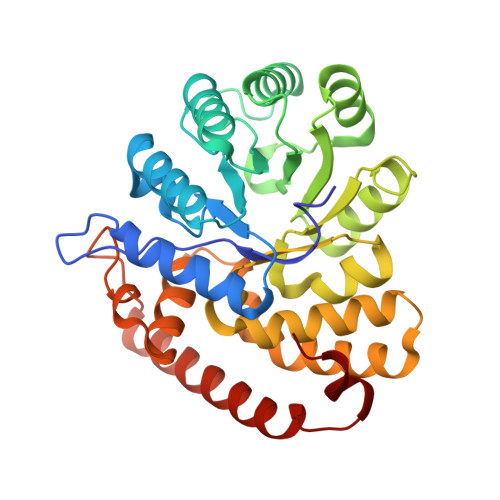l-Hydroxyproline and d-Proline Catabolism in Sinorhizobium meliloti.
Chen, S., White, C.E., diCenzo, G.C., Zhang, Y., Stogios, P.J., Savchenko, A., Finan, T.M.(2016) J Bacteriol 198: 1171-1181
- PubMed: 26833407
- DOI: https://doi.org/10.1128/JB.00961-15
- Primary Citation of Related Structures:
5CZJ - PubMed Abstract:
Sinorhizobium meliloti forms N2-fixing root nodules on alfalfa, and as a free-living bacterium, it can grow on a very broad range of substrates, including l-proline and several related compounds, such as proline betaine, trans-4-hydroxy-l-proline (trans-4-l-Hyp), and cis-4-hydroxy-d-proline (cis-4-d-Hyp). Fourteen hyp genes are induced upon growth of S. meliloti on trans-4-l-Hyp, and of those, hypMNPQ encodes an ABC-type trans-4-l-Hyp transporter and hypRE encodes an epimerase that converts trans-4-l-Hyp to cis-4-d-Hyp in the bacterial cytoplasm. Here, we present evidence that the HypO, HypD, and HypH proteins catalyze the remaining steps in which cis-4-d-Hyp is converted to α-ketoglutarate. The HypO protein functions as a d-amino acid dehydrogenase, converting cis-4-d-Hyp to Δ(1)-pyrroline-4-hydroxy-2-carboxylate, which is deaminated by HypD to α-ketoglutarate semialdehyde and then converted to α-ketoglutarate by HypH. The crystal structure of HypD revealed it to be a member of the N-acetylneuraminate lyase subfamily of the (α/β)8 protein family and is consistent with the known enzymatic mechanism for other members of the group. It was also shown that S. meliloti can catabolize d-proline as both a carbon and a nitrogen source, that d-proline can complement l-proline auxotrophy, and that the catabolism of d-proline is dependent on the hyp cluster. Transport of d-proline involves the HypMNPQ transporter, following which d-proline is converted to Δ(1)-pyrroline-2-carboxylate (P2C) largely via HypO. The P2C is converted to l-proline through the NADPH-dependent reduction of P2C by the previously uncharacterized HypS protein. Thus, overall, we have now completed detailed genetic and/or biochemical characterization of 9 of the 14 hyp genes.
Organizational Affiliation:
Department of Biology, McMaster University, Hamilton, Ontario, Canada.














